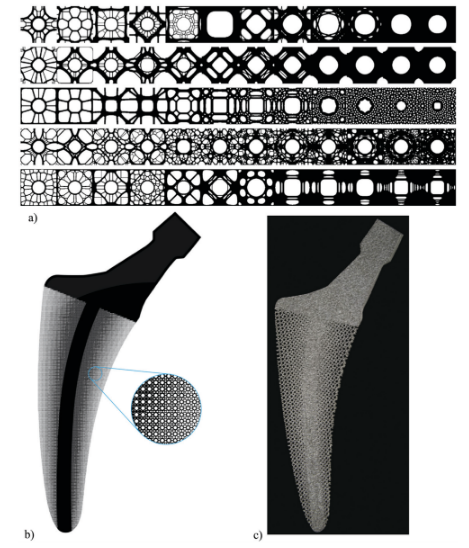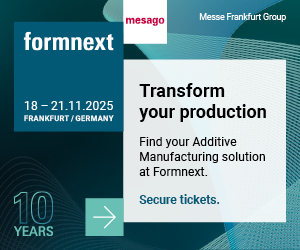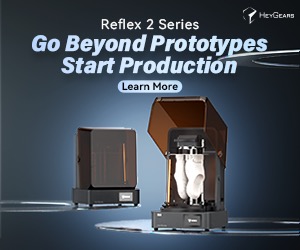Porous Metallic Biomaterials Rely on Additive Manufacturing Processes for Substitute Bone Regeneration Structures
In ‘Additively manufactured porous metallic biomaterials,’ Amir A. Zadpoor explores porous metallic biomaterials in research for bone tissue regeneration, discussing elements such as design, manufacturing, and bio-functionalization—as well as examining the ‘designer material’ angle.
Bone regeneration has historically been an extremely challenging area, even with the advent of bioprinting, and the use of lattice structures created with human cells. In this study, Zadpoor reviews porous metallic biomaterials created through additive manufacturing, along with issues such as poor ingrowth, osseointegration, and lack of regeneration. Zadpoor sees the potential for better bioprinting for bone regeneration with the use of porous metallic biomaterials.
The author considers rational design at length in terms of:
- Mechanics and physics theories
- Computational models
- Analytical solutions
- Physical reasoning
Because topological designs may be so complex, users may not be able to produce them through traditional methods and may need to lean on additive manufacturing processes instead.
“Fabrication of topologically ordered lattice structures is one of the areas where AM is the only feasible option and where rational design approaches could play an important role in topological design of the materials,” states the author. ”It is important to realize that the type and dimensions of the unit cell do not need to remain the same throughout the entire implant, as graded designs could offer additional freedom in meeting the design objectives particularly when one is trying to meet competing objectives.”
With such responsibility placed on researchers to fine-tune additive manufacturing techniques for fabricating bone substitutes, they must consider comprehensive design requirements—after which, numerous techniques can be used to create the best structures.
“There is, therefore, a need for predictive models that establish the ‘topology–property relationship’ and an optimization procedure that uses the ‘topology–property relationship’ to determine the topological design that satisfies the design requirements,” states Zadpoor.
In most cases, beam-based or sheet-based unit cells have been used, and Zadpoor states that there is the potential for combining the two in design, but there has not been much research in that area so far.

The beam-based unit cells could be very different in geometry but are usually some type of polyhedron.
“The other important type of variation in unit cell design is spatially varying the type or the dimensions of the repeating unit cell so as to obtain different properties at different regions of the implant, thereby satisfying competing design requirements or creating new advanced functionalities. These types of designs are called ‘gradient structures’ or ‘(functionally) graded structures,’ states Zadpoor.
It is expected too that better solutions and improved algorithms will be created in topological design. Zadpoor points out that other factors should be reviewed too though in relation to topological design and varying properties, to include:
- Design of AM porous biomaterials and their quasi-static mechanical properties
- Topological design and fatigue behavior
- Topological design and mass transport properties
- Topological design and implant-associated infections
Researchers must also choose the correct parameters for success in 3D printing lattice structures, with use of support structures minimized as much as possible, ‘particularly inside the volume of the porous biomaterial.’
“Regardless of the available level of mechanical support, overhangs whose angle with respect to the powder bed is below a certain threshold or whose length is above a certain threshold will require support structures,” says Zadpoor. “Although the exact thresholds are dependent on multiple processing parameters including the magnitude of the compaction, force and the type of the material, overhangs with angles below 45 degrees usually require support structures.
There are also many other parameters to consider, such as powers, and both speed and pattern of scanning. Zadpoor is confident in the potential offered by AM porous metallic biomaterials because they do possess the necessary mechanical properties, along with the following:
- Suitable ranges of mass transport properties
- Surface curvatures conducive to tissue regeneration
- Adjustable biodegradability
- Large surface areas for bio-functionalization
- Large pore spaces
“An ever-present feature in all above-mentioned properties is that they could be adjusted through rational topological design of the biomaterials. This makes AM porous biomaterials highly adjustable and affords them a lot of flexibility to meet the multiple design objectives that are required for proper functioning of bone substitutes and orthopedic implants,” says Zadpoor.
Tissue engineering for bone regeneration is a major topic as it is difficult to achieve—and much needed for patients undergoing medical treatment around the world. Today, researchers have seen potential for success in using titanium, along with nanofiber coated scaffolds, and other materials such as magnesium alloys. What do you think of this news? Let us know your thoughts! Join the discussion of this and other 3D printing topics at 3DPrintBoard.com.

A number of AM porous metallic biomaterials including the cylindrical specimens used for mechanical testing (a), a functionally graded porous structure in the shape of the femur with different porosities (b), hip stems with external and internal porous structures (c), and multiple miniaturized porous specimens (d). Most specimens are designed and fabricated from the titanium alloy Ti–6Al–4V at the Additive Manufacturing Lab (TU Delft).

Topology optimization of lattice structures while respecting the compatibility between neighboring unit cells (a). This approach can be used to design (b) and AM (c) orthopaedic implants with functional gradients (reprinted from ref. 87 with permission from Elsevier).
Subscribe to Our Email Newsletter
Stay up-to-date on all the latest news from the 3D printing industry and receive information and offers from third party vendors.
Print Services
Upload your 3D Models and get them printed quickly and efficiently.
You May Also Like
Korean Doctors Use 3D Printing to Replace Entire Ankle Bone in Groundbreaking Surgery
A team of orthopedic surgeons in South Korea has successfully replaced an entire ankle bone — the talus — with a custom 3D printed titanium implant. The study, published in...
Scientists 3D Print a Functional Human Colon Model to Study Cancer and Drug Response
Researchers at the University of California, Irvine (UC Irvine), and the New York Institute of Technology have 3D printed one of the most realistic models of the human colon ever...
Atlanta VA First in U.S. Veterans Health Care System to Offer 3D Printed Casts & Splints
The potential for additive manufacturing (AM) in the military is by no means limited to applications like propulsion hardware, drones, and explosives. 3D printed medical devices, for instance, have attracted...
China Builds World’s Largest 3D Printed Drug Factory in Nanjing
In the Jiangning high-tech zone of Nanjing, China, a new kind of pharmaceutical factory is emerging, except that this is not the usual conveyor belt or assembly line pharma factory....






































